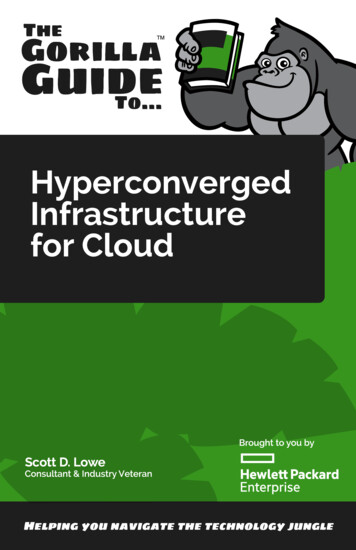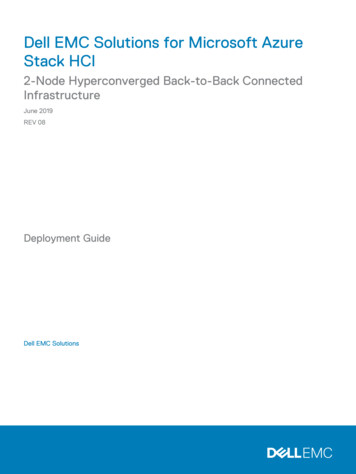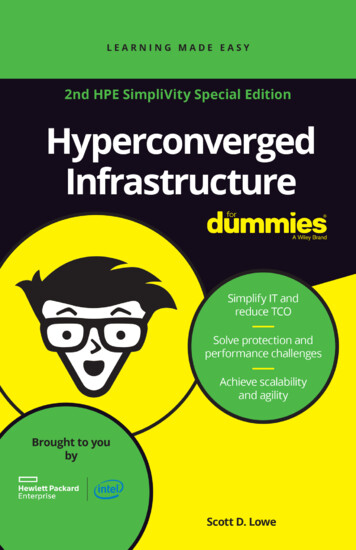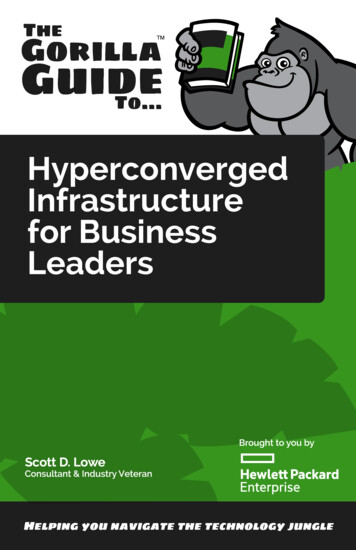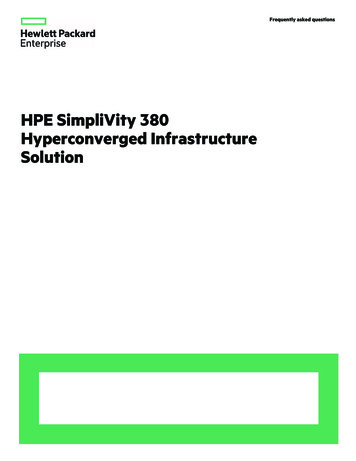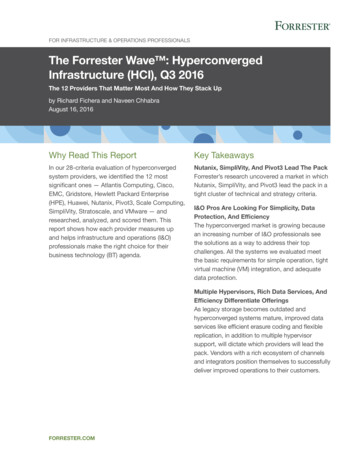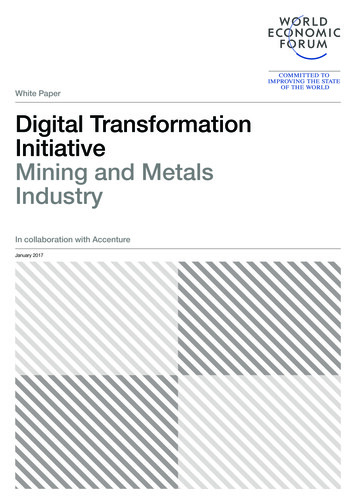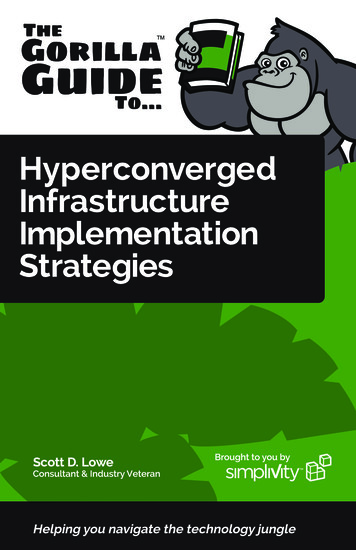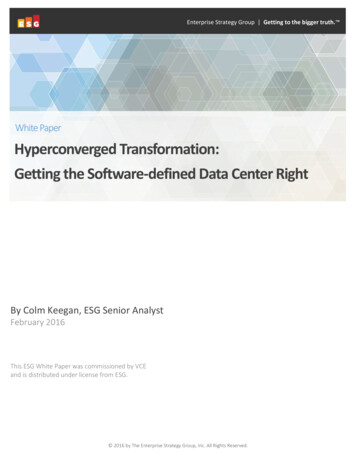
Transcription
Enterprise Strategy Group Getting to the bigger truth. White PaperHyperconverged Transformation:Getting the Software-defined Data Center RightBy Colm Keegan, ESG Senior AnalystFebruary 2016This ESG White Paper was commissioned by VCEand is distributed under license from ESG. 2016 by The Enterprise Strategy Group, Inc. All Rights Reserved.
White Paper: Hyperconverged Transformation: Getting the Software-defined Data Center Right2ContentsHyperconverged Infrastructure on the Rise . 3What Is Hyperconverged Infrastructure? . 3Start Small and Scale Granularly? . 4Limited Storage Services . 4The VxRail Appliance—An EMC VCE Hyperconverged Infrastructure Solution . 4Flexible Configuration Options . 4Performance Optimized . 4All-Flash Hyperconverged Appliance . 4Storage Service Efficiency . 5Automated Performance Management. 5Support for Virtualized and Bare Metal Servers . 6Private/Hybrid Cloud Integration. 6NSX Integration . 6Centralized Visibility and Control. 7SDDC Building Block Design . 7Configuration Flexibility and High Scalability . 7The Bigger Truth. 8 2016 by The Enterprise Strategy Group, Inc. All Rights Reserved.
White Paper: Hyperconverged Transformation: Getting the Software-defined Data Center Right3Hyperconverged Infrastructure on the RiseIT planners are increasingly turning toward hyperconverged infrastructure (HCI) solutions to simplify and speed upinfrastructure deployments, ease day-to-day operational management, reduce costs, and increase IT speed and agility. Infact, according to recent ESG research, 70% of IT respondents indicated they plan to invest in HCI over the next 24 months(see Figure 1).1FIGURE 1. Usage of/Plans for Converged and Hyperconverged Infrastructure Technology SolutionsPlease indicate your organization’s usage of or plans for converged and hyper-convergedinfrastructure technology solutions. (Percent of respondents, N 308)Currently useDo not currently use, but we plan toNo use or plans at this time but we are interestedNo use, plans, or interest at this timeDon’t knowConverged infrastructure32%Hyper-converged infrastructure56%15%0%10%7% 2% 2%70%20%30%40%50%10% 2% 3%60%70%80%90%100%Source: Enterprise Strategy Group, 2016What Is Hyperconverged Infrastructure?HCI consists of a nodal-based architecture whereby all the required virtualized compute, storage, and networking assetsare self-contained inside individual nodes. These nodes are, in effect, discrete virtualized computing resources “in a box.”However, they are typically grouped together to provide resiliency, high performance, and flexible resource pooling. Andsince HCI appliances can scale out to large configurations over time, these systems can provide businesses with investmentprotection and a simpler, more agile, and cost-effective way to deploy virtualized computing infrastructure.Another important attribute of HCI is ease of management. With minimal training, HCI systems can typically be masteredby the veteran administrator or the IT novice alike.VSPEX BLUE was EMC and VMware’s initial HCI solution offering. This platform combines VMware vSphere and Virtual SAN,along with server compute, tiered storage (flash and HDD) resources and networking components to deliver a fullyintegrated, software-defined data center (SDDC) solution. As a first generation HCI product, however, VSPEX BLUE oftenpaled in comparison with competitive HCI technologies.1Source: ESG Research Report, The Cloud Computing Spectrum, from Private to Hybrid, to be published. 2016 by The Enterprise Strategy Group, Inc. All Rights Reserved.
White Paper: Hyperconverged Transformation: Getting the Software-defined Data Center Right4Start Small and Scale Granularly?One of the primary limitations on the first generation edition of VSPEX BLUE is that it didn’t provide for the same levels offlexible deployment and granular scaling capabilities that end-users have come to expect from HCI platforms. For example,many competitive HCI solutions allow users to start with a three-node configuration and then scale up in increments assmall as a single node. VSPEX BLUE, on the other hand, required a four-node configuration starter kit and could only scaleup in four-node increments. This rigidity in scaling a VSPEX BLUE environment could very likely result in overprovisionedand underutilized infrastructure and ultimately, a higher total cost of ownership compared with other solutions. This isparticularly true for smaller data center environments and remote/branch offices where the ability to granularly scaleserver compute and storage resources is especially important.Limited Storage ServicesAnother limitation with VSPEX BLUE is its lack of data storage services like data deduplication and compression. Datadeduplication can deliver significant storage savings to virtual desktop infrastructure (VDI), user file sharing applications,and email systems. Likewise, data compression can deliver up to 50% storage reductions in database applicationenvironments like Microsoft SQL. Lacking these storage services, businesses will likely consume more storage resourcesfaster and incur higher costs over time.The VxRail Appliance—An EMC VCE Hyperconverged Infrastructure Solution“VxRail” is a hyperconverged appliance offering delivered by VMware and EMC VCE that addresses the shortcomings of theVSPEX BLUE offering. Designed to meet the virtualized computing requirements of mid-sized data centers and remoteenterprise edge locations, VCE’s VxRail Appliance will be sold and supported by VCE, EMC, VMware, and their combinedpartner ecosystems. Through tight integration with vSphere 6.0 and Virtual SAN 6.1, VxRail administrators can continueleveraging the same VMware management tools that they are already familiar with to manage a holistic, software-defineddata center stack of virtualized compute, storage, and networking resources.Flexible Configuration OptionsTo address the shortcomings of the VSPEX BLUE offering, VMware and EMC co-developed the VxRail Appliance to create acost-effective and highly scalable HCI solution that provides flexible configuration and deployment options; more granularscaling of compute, memory, and storage resources; and highly efficient deduplication storage data services. VSPEX BLUEcustomers who wish to integrate their existing environment into a VCE VxRail Appliance configuration can do so through ano-charge EMC VCE professional services engagement.Performance OptimizedThe VxRail Appliance is integrated with vSphere 6.0 and Virtual SAN 6.1 to provide businesses with a highly scalablearchitecture that can be configured with a mix of flash and hard disk drives, or deployed as an all-flash array. This givesbusinesses the ability to support a wide variety of application workloads, from virtual desktops and test and developmentenvironments to end-user file sharing and business applications. Moreover, through the storage I/O and cacheoptimization enhancements delivered in Virtual SAN 6.1, application workloads can gain up to a 2x performance boost.These performance improvements can enhance application service levels and potentially increase infrastructureefficiencies by enabling virtual administrators to increase VM to server densities across their environments.All-Flash Hyperconverged ApplianceMany organizations are opting to deploy all-flash appliances as a way to provide the highest levels of storage I/Operformance for their business-critical applications. In addition to performance improvements, all-flash arrays can 2016 by The Enterprise Strategy Group, Inc. All Rights Reserved.
White Paper: Hyperconverged Transformation: Getting the Software-defined Data Center Right5potentially enable businesses to pack more VMs per host, thus improving the ROI on their virtual infrastructureinvestments. The VxRail appliance can be implemented as an all-flash storage configuration to help deliver sustainableapplication performance improvements and increased VM to server densities across growing virtualized data centerenvironments.Storage Service EfficiencyThe VxRail Appliance can yield up to 50% storage savings thanks to in-line data deduplication. Optimized for all flash arrayconfigurations, VxRail’s data deduplication services can help extend the life of flash investments and reduce flash storageconsumption by reducing write I/O activity. This is especially important in application environments where there is a highdegree of data commonality. Virtual machine and virtual desktop images, for example, often contain much of the sameoperating system data, boot files, etc. But without deduplication, these images and all their requisite data have to beprotected on persistent storage. Data deduplication helps eliminate this redundancy, so that more information can bestored on less physical storage capacity, helping to improve storage efficiencies and reduce ongoing costs.VCE is also providing support for data compression services on the VxRail Appliance. This will provide additional storageefficiencies for database application workloads.Automated Performance ManagementIn addition to these enhancements, VMware and VCE are enabling virtualized workload performance automation on theVxRail Appliance, through virtual machine quality-of-service (QoS) policies. VxRail Appliance administrators will be able toassign application performance policies at a VM level to ensure that business-critical application performance remainsconsistent. This is an especially important capability given that contention for CPU and storage I/O resources can increasein highly virtualized, multi-tenant environments. In fact, according to ESG research, virtual administrators cite maintainingconsistent application performance as a necessary development in the improvement of their server virtualizationenvironment (see Figure 2).2By enabling virtual administrators to pre-allocate and prioritize access to IOPS based on the performance profilerequirements of the VM, VxRail’s QoS technology can enable businesses to improve application service levels and mitigaterisk.2Source: ESG Research, VMware Cloud Operations Management Research, 2015. 2016 by The Enterprise Strategy Group, Inc. All Rights Reserved.
White Paper: Hyperconverged Transformation: Getting the Software-defined Data Center Right6FIGURE 2. Developments Needed to Improve Management of Server Virtualization EnvironmentWhich of the following developments do you believe need to take place in order to improvethe management of your organization’s server virtualization environment? (Percent ofrespondents, N 251, multiple responses accepted)Better security designed for virtual environments39%Better performance management31%Better integration between infrastructure andvirtualization management solutions29%Improved capacity planning/forecasting29%Better integration with existing managementframeworks29%Source: Enterprise Strategy Group, 2016Support for Virtualized and Bare Metal ServersIn the second half of 2016, the VxRail Appliance will release support for iSCSI data services. This feature will allow datacenters to share VxRail Appliance virtualized storage resources with bare metal servers and third-party hypervisors, andwill support Microsoft Cluster Server. This flexible resource sharing can provide IT administrators with a simplified way tomanage a common pool of elastic private cloud storage resources that can be shared and centrally managed across bothvirtualized and physical hosts in the data center.Private/Hybrid Cloud IntegrationMany organizations are leveraging public cloud storage for low-cost data archiving, backup, and DR. EMC’s CloudArraytechnology ships with VxRail Appliances to provide businesses with a simple way to integrate with public or private cloudstorage resources (like AWS, Google, or vCloud Air) via iSCSI, CIFS, or NFS. This gives IT organizations multiple options forarchiving and/or protecting data in centralized data centers or remote office locations—back to storage resources in eithera private, public, or hybrid cloud fashion.In addition, VxRail’s multiple integration points with VMware vCloud Air provide businesses with essentially an “out-of-thebox” hybrid cloud computing platform to support additional use cases like dev/test, VDI, and application workloadbalancing in the public cloud.NSX IntegrationVirtualized network infrastructure is the third stool in the software-defined data center environment. While the VxRailAppliance provides integrated support with VMware’s NSX network virtualization technology, businesses can choose tointegrate VxRail with their existing physical network or utilize it with NSX. This choice of network preserves existinginvestments while helping IT organizations future-proof their environments. 2016 by The Enterprise Strategy Group, Inc. All Rights Reserved.
White Paper: Hyperconverged Transformation: Getting the Software-defined Data Center Right7Centralized Visibility and ControlVCE’s Vision management software is integrated with every VxRail Appliance to provide virtual and private cloudadministrators with a single view of performance and system health. In addition, busy systems administrators can leverageVision’s automated patch and update process to save time and further simplify operational management.SDDC Building Block DesignVxRail Appliances are built on a 2U form factor node, or SDDC building block, that starts at a four-node applianceconfiguration. Three-node VxRail Appliance deployments along with single-node scaling will soon be supported. Table 1displays the four available VxRail models.TABLE 1. VxRail Models (SDDC Building Block)VxRail 120VxRail 160VxRail 200VxRail 6012 Cores with 2xIntel Xeon Processor E5-2620 v3 2.4GHz128/192 GB RAM, 3.6-6 TB (per node)Supports up to 14 TB of flash16 Cores with 2xIntel Xeon Processor E5-2630 v3 2.4GHz256/512 GB RAM, 4.8-6 TB (per node)Supports up to 19 TB of flash20 Cores with 2xIntel Xeon Processor E5-2660 v3 2.6GHz256/512GB RAM, 4.8-6 TB (per node)Supports up to 19 TB of flash6 Cores with 1xIntel Xeon Processor E5-2603 v3 1.6GHz(Q2 2016)Configuration Flexibility and High ScalabilityEach VxRail Appliance model supports a mix of flash and HDD storage media, and these appliances can also be configuredin all-flash configurations. Each appliance consists of four nodes and each node contains of CPU, storage, and networkingI/O resources. Appliances can be clustered together, up to a maximum of 16 in a cluster, to provide for very high levels ofscalability.And to provide for more granular scaling of CPU and storage resources, it is possible to mix and match VxRail models withina cluster. For example, if a VxRail 120 cluster needs to incorporate additional CPU horsepower, 160 or 200 appliances canbe added to the cluster non-disruptively. This enables businesses to flexibly configure their data center environment tostay in lock step with the changing needs of their application workloads. 2016 by The Enterprise Strategy Group, Inc. All Rights Reserved.
White Paper: Hyperconverged Transformation: Getting the Software-defined Data Center Right8The Bigger TruthIn ESG’s recent survey on hybrid cloud infrastructure trends, 85% of the respondents indicated that the foundation of theirprivate cloud environment would be based on their existing investments in virtualized infrastructure.3 As the clear leader inthe virtualization market, VMware is in a unique position to help IT organizations extend the same operational benefitsthat they have realized through virtualized computing capabilities to their storage and networking environments and do sowith hybrid cloud computing in mind. The challenge is that, while many organizations have been able to automate howthey manage and provision virtualized computing resources, they are often still managing storage and networkinginfrastructure in discrete silos. This often leads to increased management complexity, higher costs, and protracted delaysin delivering virtualized application resources for new business services. Hence the strong interest in HCI technology as avehicle to unify, virtualize, and operationally automate the entire application infrastructure stack.Suffice it to say, EMC’s generation-one HCI offering, VSPEX BLUE, was not well received by the market. VMware and VCE,however, have given their HCI technology a much-needed facelift. The new VMware and VCE VxRail Appliance offeringcould make for a very compelling offering to those businesses that are looking for a way to implement a highly flexible andhighly scalable HCI appliance in their environments, with private and hybrid cloud computing capabilities, while stillleveraging the same VMware management tools that they have been using for years. With VxRail’s tight integration ofvSphere 6.0, Virtual SAN 6.1, and vCloud Air, mid-sized data center environments and enterprise edge locations can gainthe benefits of management simplicity, application performance automation, enhanced infrastructure efficiency, andhybrid cloud computing scalability. These are all critically important capabilities given the fact that the IT skill sets requiredto manage separate silos of compute, storage, and networking infrastructure are often lacking in many of theseenvironments.It appears that the VxRail solution addresses many of the technical limitations and configuration shortcomings of its VSPEXBLUE forerunner to make it a much more appealing offering to IT buyers. Perhaps most notably, through VM-definable QoSpolicies, VxRail reflects VCE’s intent to help deliver on the promise of VMware’s software-defined data center (SDDC). Andas businesses continue their virtualization journeys down the infrastructure stack, VMware’s software-defined networkingtechnology, NSX, will help make the SDDC that much more of a reality.It is also important to point out that as part of the VCE family of Blocks, Racks, and Appliance technologies, VxRail can beleveraged as part of a core-to-edge strategy for those organizations wishing to get the best of both worlds from convergedand hyperconverged technologies. And since VCE’s Vision management software can be utilized to manage all of theseofferings through a single pane of glass, it can provide IT organizations with the increased management simplicity andoperational automation needed across private and hybrid cloud computing environments.3Source: ESG Research Report, The Cloud Computing Spectrum, from Private to Hybrid, to be published. 2016 by The Enterprise Strategy Group, Inc. All Rights Reserved.
All trademark names are property of their respective companies. Information contained in this publication has been obtained by sources TheEnterprise Strategy Group (ESG) considers to be reliable but is not warranted by ESG. This publication may contain opinions of ESG, which are subjectto change from time to time. This publication is copyrighted by The Enterprise Strategy Group, Inc. Any reproduction or redistribution of thispublication, in whole or in part, whether in hard-copy format, electronically, or otherwise to persons not authorized to receive it, without the expressconsent of The Enterprise Strategy Group, Inc., is in violation of U.S. copyright law and will be subject to an action for civil damages and, if applicable,criminal prosecution. Should you have any questions, please contact ESG Client Relations at 508.482.0188.Enterprise Strategy Group is an IT analyst, research, validation, and strategy firm that providesactionable insight and intelligence to the global IT community. 2016 by The Enterprise Strategy Group, Inc. All Rights Reserved.www.esg-global.com 2016 by The Enterprisecontact@esg-global.comStrategy Group, Inc. All Rights Reserved.P. 508.482.0188
VSPEX BLUE was EMC and VMware's initial HCI solution offering. This platform combines VMware vSphere and Virtual SAN, along with server compute, tiered storage (flash and HDD) resources and networking components to deliver a fully integrated, software-defined data center (SDDC) solution. As a first generation HCI product, however, VSPEX BLUE .
